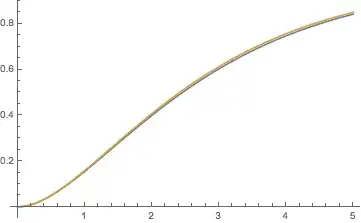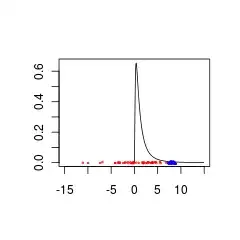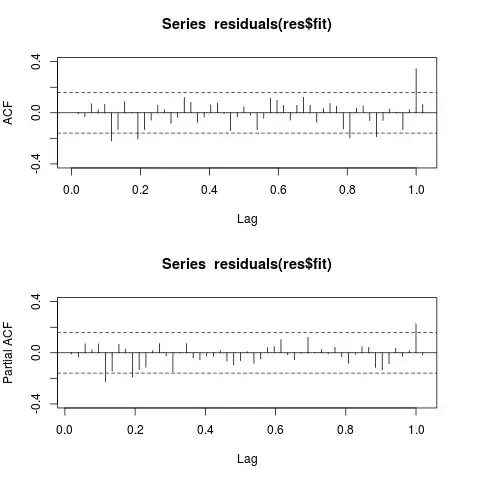How to statistically compare two time series?
After reading the above responses, I realized that what I should be doing for my data is exactly what https://stats.stackexchange.com/users/3382/irishstat recommended. However, I am having trouble determining the correct parameters for the arima(p,d,q) function in r. Could someone provide a detailed tutorial for how to correctly choose these values? I know that the time series need to be stationary, which is simple enough to test. I also know the acf/pacf graphs are used for this, but it's still a bit foggy and I want my statistics to be sound. I have been unable to find a successful guide- most of the walkthroughs I have seen skim over the part of choosing the p,d,q values.
EDIT: I've added the 2 time series that I have been working on. The data is sampled bi-monthly for 9 months (excepting Dec, Jan, and Feb). alpha, in this case, is the TN data aggregated by month and year, which allowed me to coerce it to a time series. For our purposes, monthly averages are good enough to display what we are trying to look at. Another important note, these 2 time series have the proper time window, etc., but they are merely examples. They are not the final time series that I will use in the analysis. Final note, the NAs in the first time series caused gaps in the plots, but it is not difficult to apply a gap-filling function, which would generate a plot much like the second.
These time series are clearly not models, but simply points stored in the time series format. I believe that using a model is the best way to compare them, but I am not sure. I was also able to decompose the model to remove the seasonal data, and I was curious if it would be better to compare the series with the seasonal component removed.
alpha <- with(alpha,
aggregate(TN~Month+Year, FUN = mean, na.rm=T)
)
> alpha
Month Year TN
1 3 2011 2.550675
2 4 2011 2.166793
3 5 2011 1.666279
4 6 2011 1.235067
5 7 2011 1.306130
6 8 2011 1.380530
7 9 2011 1.434623
8 10 2011 1.599755
9 11 2011 2.261617
10 3 2012 2.529887
11 4 2012 1.938779
12 5 2012 1.700785
13 6 2012 1.160013
14 7 2012 1.099877
15 8 2012 1.244322
16 9 2012 1.471384
17 10 2012 1.695036
18 11 2012 1.959646
19 3 2013 2.808547
20 4 2013 2.546227
21 5 2013 2.112756
22 6 2013 1.875753
23 7 2013 1.882885
24 8 2013 2.010292
25 9 2013 1.771419
26 10 2013 1.820127
27 11 2013 2.351775
28 3 2014 3.002976
29 4 2014 2.286398
30 5 2014 2.177926
31 6 2014 1.772718
32 7 2014 1.245376
33 8 2014 1.274671
34 9 2014 1.378657
35 10 2014 1.554602
36 11 2014 1.702360
37 3 2015 2.771875
38 4 2015 2.373219
39 5 2015 2.025162
40 6 2015 1.607793
41 7 2015 1.656044
42 8 2015 1.525059
43 9 2015 1.494547
44 10 2015 1.746673
45 11 2015 1.942351
V1 <- as.numeric(rep(c(12,1,2),4))
V2 <- as.numeric(c(2011, rep(2012,3), rep(2013,3), rep(2014,3),rep(2015,2)))
V3 <- rep(NA, 12)
df1 <- data.frame(V1,V2,V3)
names(df1) <- c('Month', 'Year', 'TN')
TNMonthsFilled <- rbind(alpha, df1) #adds in dates for Dec-Feb as NAs
TNMonthsFilled$Date <- as.Date(with(TNMonthsFilled, paste(Year, as.numeric(Month), as.numeric(15),sep="-")), "%Y-%m-%d") #converts values back to dates
TNOrdered <- TNMonthsFilled[order(TNMonthsFilled$Date),] #orders dates for coercion to ts
TNts <- with(TNOrdered, ts(TN, start = c(2011,3), end = c(2015,11), frequency = 12)) #TS with NAs
plot(TNts)
Nan_Up_Ag <- with(Nan_Up,
aggregate(TN~Date, FUN = mean, na.rm=T)
)
> Nan_Up_Ag
Date TN
1 2011-04-15 3.3625000
2 2011-05-15 2.8972222
3 2011-06-15 3.6680000
4 2011-07-15 1.8125000
5 2011-08-15 1.5816667
6 2011-09-15 2.5475000
7 2011-10-15 3.4550000
8 2011-11-15 3.9600000
9 2012-04-15 3.5683333
10 2012-05-15 2.6991667
11 2012-06-15 2.0630000
12 2012-07-15 1.6233333
13 2012-08-15 1.4250000
14 2012-09-15 2.3961111
15 2012-10-15 2.9616667
16 2012-11-15 3.8216667
17 2013-03-15 4.6820000
18 2013-04-15 5.6225000
19 2013-05-15 3.5658333
20 2013-06-15 0.4916667
21 2013-07-15 2.8266667
22 2013-08-15 2.9216667
23 2013-09-15 2.7991667
24 2013-10-15 2.5875000
25 2013-11-15 3.4583333
26 2014-03-15 4.6200000
27 2014-04-15 3.9941667
28 2014-05-15 3.4116667
29 2014-06-15 2.8661111
30 2014-07-15 2.2483333
31 2014-08-15 2.0416667
32 2014-09-15 2.1316667
33 2014-10-15 2.6465000
34 2014-11-15 3.2133333
35 2015-03-15 4.1460000
36 2015-04-15 4.1650000
37 2015-05-15 3.6616667
38 2015-06-15 3.0483333
39 2015-07-15 2.8133333
40 2015-08-15 2.4466667
41 2015-09-15 2.1983333
42 2015-10-15 3.0233333
43 2015-11-15 3.3060000
Nan_Up_ts <- with(Nan_Up_Ag, ts(TN, start = c(2011,3), end = c(2015,11), frequency = 12))
plot.ts(Nan_Up_ts)



